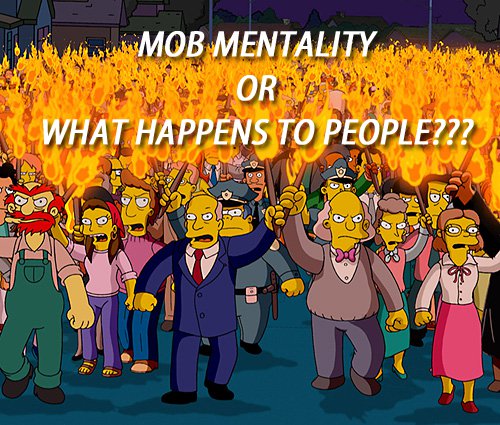Herd Mentality Related to Bullying?

What is mob mentality??? Photo credit: Hubpages
March 30, 2018
Herd Mentality, according to Oxford Dictionary, is the tendency for people’s behavior or beliefs to conform to those of the group to which they belong. Buying the latest iPhone, watching a show that everyone is obsessing over, even going Black Friday shopping are all examples of herd mentality. Claire Song (11) notices herd mentality “at Yorba Linda High School. People are trying to keep up with the crowd.” Although herd mentality, for the most part, is harmless, mob mentality can have serious influences on bullying.
To start, there are many forms of bullying: cyberbullying, verbal bullying, physical bullying…etc. While cyberbullying may take place online and verbal bullying seems futile compared to either physical abuse or sexual exploitation, they are all forms of harassment that cannot be overlooked. In an article by the DoSomething organization, “3.2 million students are victims of bullying each year. About 160,000 teenagers will skip school each day because of bullying.” As the means of finding ways to solve this growing problem becomes more desperate, young students are, to this day, falling victim to the physical and psychological abuse of bullies. It is evident in the increasing number of suicides due to bullying that the programs implemented on society for helping/preventing further victims are not working. What our society desperately needs is awareness. Websites such as “StopBullying.gov” or “nobullying.com” support cliché answers like “contact teachers” or “ talk to your counselors/ parents” that have very minimal results. To clarify, we need to bring awareness to the cause rather than the result of bullying and make it the students’ responsibility to protect their peers rather than the faculty members of the school.
All humans have a natural instinct to fit in, this is the foundation of herd mentality – aka mob mentality. The victims of bullying are usually those that stand out or doesn’t fit into the rest of society. This “social limitation” results in our obsession with the popular media. Especially today when everybody has a phone, being “connected” is addictive. Celebrities go on crazy diets to maintain an unhealthy physique which influences young adults to do the same. On a trending Buzzfeed Youtube series, employees of Buzzfeed tried various celebrities diets including Beyonce, the Kardashians, and even a Victoria Secret model. As the society stresses the importance of being a certain weight, a certain skin color, a certain personality, children and teenagers become more aware of their and other peoples’ bodies. Herd mentality can also be the cause of why people join in on the “torment.” Right now, while reading this article, readers may wonder why people would do such a thing. Why would a person hurt another person? The excuse is quite simple: “because he/she was doing it too.” Once bullying starts and gains momentum, the harder it is to stop. Students would watch another person get bullied and feel inclined to join in to feel validated. On the other hand, people watching and knowing about a certain someone being pushed around at school, but not doing anything about it is called the bystander effect. Although the bystander effect is a horrible matter, it is quite understandable. While bystanders who do not take action also allow for the perpetuation of bullying, the Bystander effect happens because of our inherent fear of standing out. Standing up for someone that has already been outcasted, makes us fear that we will also be outcasted. It is in no shape or form justifiable, but rather a natural instinct.
So… what can we do about it? What am I actually saying? The whole point of this article is to advocate a stop to bullying before it even starts. Instead of only glorifying celebrities with amazing bodies, be inspired by celebrities that aren’t so… beautiful. As this publication has mentioned before, mob mentality is a natural thing. With that in mind, the idea of trying to fit in with the crowd will never go away. Yet, instead of shrinking the circle of “acceptable traits” expand it. Expand the boundaries so that everyone can be included. Herd mentality doesn’t always have to be bad. In fact, as the saying goes, “ alone we are strong, but together we are stronger.” If we all are willing to expand the boundaries, then what is there to fear?










































